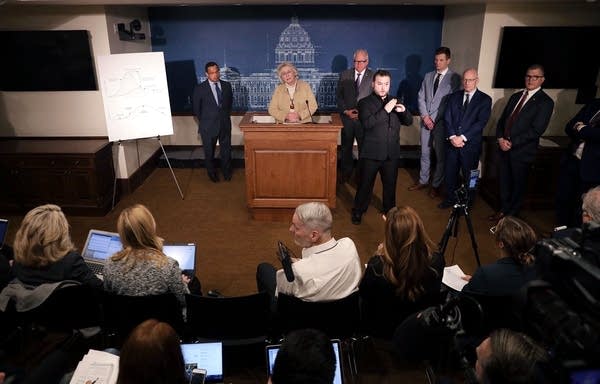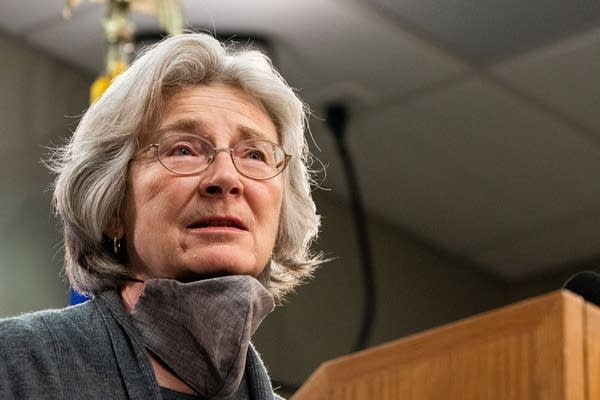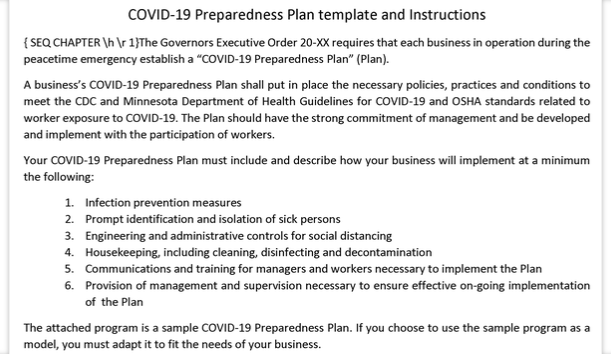At the eye of the COVID-19 storm
A behind-the-scenes look at how Gov. Tim Walz and key advisers addressed the Minnesota pandemic.

Go Deeper.
Create an account or log in to save stories.
Like this?
Thanks for liking this story! We have added it to a list of your favorite stories.
Almost two months into Minnesota’s COVID-19 stay-at-home order, Gov. Tim Walz and top advisers prepared for a big pullback of restrictions that for some had provided comfort and for others had stirred impatience amid the spread of the virus.
A day ahead of that mid-May announcement, Walz chief of staff Chris Schmitter circulated the first in a series of confidential previews to agency heads and key aides “to get everyone on the same page.” The plan, he wrote, was to drop the stay-at-home restrictions days later and offer a clear roadmap for businesses clamoring to welcome customers back inside.
“We want to give more of a time forecast, if possible, to give some a bit more certainty to various industries,” Schmitter told his administration colleagues as he set a rollout plan in motion for legal memos, explanatory slides, press release materials and industry briefings.
Four hours later and after a senior leadership meeting involving Walz, Schmitter pumped the brakes. “I am concerned after further review that we’re not where I’d hoped we would be,” he wrote in a follow-up email.
Turn Up Your Support
MPR News helps you turn down the noise and build shared understanding. Turn up your support for this public resource and keep trusted journalism accessible to all.

Schmitter acknowledged questions were sure to flood in: “We will get slammed with these, from camps to sports to whatever else.”
When Walz delivered a televised address the next night, the end of the stay-home restrictions was announced as planned. But the anticipated reopening guidance would get pushed off another week as the administration’s economic and health teams sorted out “inconsistencies” in the plans.
The abrupt strategy shift is captured among thousands of pages of correspondence, private memos and other documents released to MPR News under a public records request fulfilled this July, well more than a year after it was filed.
The materials offer a glimpse at internal tensions and shed light on how the administration navigated the crisis early on. They detail which people, groups and industries were pushing for or against certain actions and how top officials shaped the public messaging in the face of unprecedented steps.

More than 9,000 pages cover deliberations from March through June of 2020, a time frame when schools were closed, the public was told to avoid moving about and when many businesses faced orders to stay closed or severely limit operations.
Walz’s COVID-19 actions are certain to be a campaign issue next year. The first-term Democrat and allies contend he presided over a calm, measured response against the threat of a lethal virus; his critics argue the governor went too far, kept restrictions in place too long and failed to adequately protect Minnesota’s most vulnerable people.
Executive order jockeying
During that initial phase, executive orders came almost daily and carried the force of law. Walz sped up unemployment eligibility, shifted state workers to new roles, suspended rental evictions, halted some medical procedures and took other steps to prepare the state for a possible surge in infections.
Some of the orders mirrored actions in other states while others came at the request of the affected industries. And many incited pushback.
In late April, as long-term care centers and other acute care facilities coped with staffing shortages, Walz allowed out-of-state health care professionals to provide urgent help without having a Minnesota certification.
The move annoyed the Minnesota Nurses Association, a union whose president Mary Turner had partnered just a week before with the governor on a media briefing. She and Walz spoke by phone the day before he signed the order.
“As we stated in our call, frontline workers continue to be asked to make significant sacrifices all the while receiving only platitudes and superficial appreciation from policy makers and employers,” Turner wrote in an emailed letter to Walz. “We view this Executive Order as just another example of this.”

Despite the objection, the order remained in place for a year until Walz rescinded it along with almost two dozen others in one fell swoop.
Another union ally of Walz fared much better. The AFL-CIO urged Walz to issue an executive order that barred employment sanctions against any worker who reported unsafe conditions or lack of safety gear and who refused to work due to COVID-19 hazards on the job. The labor organization supplied Walz, relevant agencies and the attorney general’s office with a draft order.
A couple of weeks after the request, an order was official and the AFL-CIO quickly distributed a press release: “Minnesota AFL-CIO Applauds Governor Walz’s Executive Order Protecting Workers from Retaliation.”
Around the same time, Walz faced a hard push from state hospitals, nursing home groups and other medical entities for an executive order waiving legal liability associated with COVID-19 care.
“Senior care providers are delivering care in these circumstances and in ways that may be seen to deviate from the prevailing standards of care — but is consistent with guidance at the time care is given,” two leaders of the Long-Term Imperative wrote to Walz at one point. “As a result, they are facing increasing threats of lawsuits.”
When the issue first arose, Walz policy adviser Emily Lefholz apprised colleagues of the liability waiver request made by an array of organizations. She wrote it was “a tough issue that the trial lawyers are extremely concerned about.” She said that level of broad immunity hadn’t fared well in the Legislature. Schmitter said the team should discuss it further, but declared himself “dubious of this.”
A set of talking points developed by the governor’s office made clear the administration wouldn’t move ahead.
“Statutory law already has strong procedures to protect against meritless claims,” the talking points read in part. “It is up to the courts to determine how the present circumstances of a global pandemic will implicate when legal liability arises.”
Decision structure
The documents provided to MPR News contain few examples of Walz weighing in himself, and only then through the assessments of key aides recalling conversations with him. Despite a request for any emails, text messages or other communication directly sent by the governor, none were released.
According to COVID-19 briefing charts, the governor, lieutenant governor and first lady received a daily 60-minute briefing on key developments in the pandemic — from testing to supplies and child care to long-term care issues. Work groups were set up to sort through granular details and develop strategy.
Schmitter appeared to have the most hands-on role in the command structure.
Either he or State Emergency Operations Center leader Joe Kelly were involved in or directed most of the briefings, and the two met with one another at the end of each day to recap and look ahead. Schmitter deferred to Department of Economic Development Commissioner Steve Grove and Health Commissioner Jan Malcolm on developing guidance for reopening measures, but told the team that he and the governor would ultimately resolve disputes in approaches between advisers.

Corporate executives and other well-known figures sometimes went through Schmitter when they had a point to get across to Walz.
Jeffrey Ettinger, a former Hormel Foods Corp. chief executive, is a major donor to Walz and gave $50,000 to the Minnesota Victory PAC in 2018 that spent millions backing his bid for governor.
Ettinger communicated regularly with Schmitter, offering praise or criticism for decisions being made or providing unsolicited advice about what moves the administration should make.
“I know these issues you all are wrestling with are extremely difficult,” Ettinger wrote to Schmitter in one May 2020 message.
Ettinger went on to question a Walz decision to only allow outdoor dining during a gradual reopening of restaurants and cautioned against taking a hard line with churches pledging to defy attendance limits.
Schmitter took a couple days to respond. “Jeff, appreciate the note. I’m sorry we haven’t been able to connect, but I’ve quite literally been going around the clock. I assure you that the perspective you’re articulating is one that was very well considered going into this week’s decision,” he said.
Celebrity chef Andrew Zimmern lobbied Schmitter to have Walz sign an executive order permitting takeaway liquor sales for restaurants and bars that couldn’t serve customers on site.

“I think this is a slam dunk. And I know that the MN restaurant community will suffer without it. With it, I know their gratitude would be super sized,” Zimmern wrote.
Schmitter responded with an invitation for Zimmern to call his state and personal cell numbers anytime. He assured Zimmern that something was in the works.
Less than a week later, the Legislature approved a bill allowing for the carryout beer and wine with restaurant food purchases. Walz signed it.
Honing messages
Some of the administration’s coordination around key decisions took place over conference calls and video chat platforms. Any recordings associated with those were not part of the batch of information released.
However, the records do offer a peek at discussions around how to present decisions publicly, balancing an appetite to project optimism with a need to preach continued caution about an unpredictable virus.
During May preparations to ease restrictions on religious service attendance, a Walz aide drafted remarks for Malcolm. It would be her role to describe the new rules, which expanded capacity for funerals, weddings and worship services.

Through an aide, Malcolm amended the draft to include considerable cautionary language.
“Even though we are slowly opening up, it doesn’t mean we are on the other side of this. This is not a return to normal,” she would plan to say.
Malcolm’s team explained to the governor’s office that the tone was important “to stress more that large gatherings are still a big concern as we see increasing case numbers and community spread.”
Collaborating with DEED on return-to-work guidance, the Health Department also worked to more firmly fashion a COVID-19 preparedness plan template for businesses. They urged insistence on precise action plans for dealing with employee illness, site cleaning and alternative work scenarios.

Early on, the administration compiled an extensive grid for state information hotline operators to route calls from the public about the pandemic response. It ran the gamut from lining them up with child care to informing them about testing availability to dealing with housing concerns.
The chart even offered “suggested things to do while home” for people anxiously calling about being locked down: “Make face masks or do craft projects,” “clean closets, clean out kids toys/games, wash carpets, clean the garage, clean kitchen cabinets, train your dog, etc.” And complete the 2020 census form.
Lawmaker pressure
Lawmakers were also pushing the administration for answers and action.
As the 2020 fishing opener approached, Republican Senate Majority Leader Paul Gazelka pressed the Department of Natural Resources commissioner and the governor’s chief of staff to ease up on restrictions affecting private fishing guides.
“Please reconsider this category. Limit people in the boat,” he wrote, adding that the window for survival of those businesses was slim. “Any business, or area, that relies on business from opening fishing to Labor Day must be given greater flexibility.”
DNR Commissioner Sarah Strommen sympathized with Gazelka’s argument but said the decision would stand for the time being.

“Social distancing in a boat is a bit more complicated, particularly when driving across water or helping an inexperienced angler net a fish (a common guide activity),” Strommen replied.
Ahead of a June call Walz was due to have with Gazelka around the pandemic and other pressing matters, the governor’s staff developed talking points. Walz was urged to push Gazelka to be collaborative rather than confrontational. In defense of his peacetime emergency, Walz was to say, “We are still in an emergency, Paul. The trajectory of this virus is uncertain.”
Many lawmakers wrote to seek a quicker wind-down of an order suspending elective medical procedures — a step done to preserve protective equipment in short supply. One brought up his father’s chronic pain and inability to get his normal level of care.
Several Democratic legislators wrote Walz aides to seek clarity on alcohol sales at golf courses.
Walz’s office had requests for Democratic lawmakers as well. When the peacetime emergency that was the underpinning of Walz’s COVID response came under fire, his staff wrote up a list of arguments DFL senators could make.
“Are DFL members ready to speak against the peacetime emergency amendment?” Walz adviser Hue Nguyen asked a colleague before the pointers went out.

Sen. Paul Utke, R-Park Rapids, pressed for answers on what kind of fireworks celebrations would be permitted around the Fourth of July. He said traditional summer events had been scrapped and small towns were clinging to hope they could still put on their annual shows.
“People at fireworks displays sit on blankets in the grass, sit on lawn chairs in the back of the pickups, sit in the boats and pontoons on the river, etc.,” Utke wrote. “There are no bleachers where people are shoulder to shoulder. I have jokingly suggested they carry signs and call it a peaceful protest because then everything is OK! That is how ridiculous this whole issue is.”
DEED Commissioner Grove pushed fellow administration leaders for a swift response.
“My take: We should allow gatherings for fireworks so long as people stay in the groups with which they came and maintain social distancing. Masks always encouraged,” Grove wrote to colleagues in early June. “I really don’t think we want the governor cancelling the 4th of July.”
Many towns called off the displays anyway.
What is essential
The Walz administration fielded countless requests from company heads, industry groups and small-shop owners to have their areas declared essential. That was key early on as the classification could mean the difference between keeping the lights on or shutting down entirely.
A cabinetmaker worried about suspending installations midstream; a pet store company said animals shouldn’t be left in limbo; bike shops said their offerings were critical during the public standstill.
Officials spent days, weeks or longer dealing with the complexities.
Minnesota Board of Cosmetology executive director Gina Fast pleaded for assistance from the governor’s office after three GOP legislators challenged her over restrictions on salons and who was setting the rules for reopening them.
“The HHS Committee oversees EVERY health licensing board and I have never experienced so much difficulty in getting basic information,” wrote committee Chair Michelle Benson, R-Ham Lake. “Literally, a phone call results in a more transparent response than you have given.”
Fast said she feared she was being made a “scapegoat” for limits on product sales and services and would be later forced out.
“I feel like I am playing a game of chess and I don’t know the rules,” she wrote to a Walz aide as she sought help from above.
A similar scenario played out in early May over massages. A Maple Grove spa owner questioned why day spas had to remain closed, but massages in medical or chiropractic settings were permitted to resume.
For almost a week, several agency officials traded emails over distinctions between the two services. Days into the dispute, one agency staffer sounded exasperated.
“I wish they could open up,” Chad Hope wrote. “I need a massage!”


